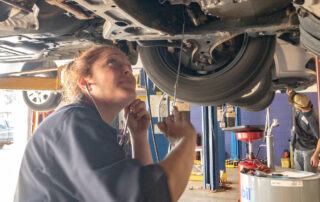They come on motorcycles, semis and buses to experience another transportation tradition. As the horn sounds, passengers with tickets in hand climb onboard for a maritime experience. The S.S. Badger is the only remaining coal-powered passenger ship in North America. It’s the largest car ferry ever to sail Lake Michigan and is longer than a football field. Its belly can swallow up massive amount of cargo, hundreds of cars and even fully loaded semi-trucks.
In its shadows, and nearly unnoticed, Kevin Diedrich arrives to work, arrives for duty and arrives home as he steps on board. Diedrich’s job starts early, “I get up around 3:30 in the morning and I go on watch and I stay on watch from four in the morning till eight
O’clock in the morning.” His shift is four hours on duty and 8 hours off, around the clock he charts a course across Lake Michigan. A course he will travel nearly 450 times in a season. Diedrich lives onboard about seven months a year and calls his quarters his, “humble home.” He enjoys the quiet of going to his room. He said, in his off hours he sleeps or reads and the history of the ship is not lost on this sailor.
Back in 1953 when the S.S. Badger out of Wisconsin and the S.S. Spartan representing Michigan set sail they took passengers and entire railroad cars across the Great Lake. Entire trains could drive onboard and the rail lines cut a path straight onto the ship.
The trains no longer use the ferry ship but the rail lines are still a visible reminder of past voyages. As a boy growing up in Manitowoc, Diedrich remembers how the “Queen of the Lakes” was an awe inspiring sight. Diedrich remembers how he’d ride with his sister to the ferry docks during summertime. He said, “We’d sit there for a couple of hours and watch them load up the railroad cars. When you’re 8, 9 years old as I was at the time you just can’t believe anything that big can float.” Big is an understatement. The S.S. Badger is six thousand, six hundred and fifty tons of hulking steel. Diedrich was always amazed at how it would maneuver in the harbor. That maneuvering in the harbor is still done from the pilothouse with the ships original big wooden wheel.
As a kid Diedrich was mesmerized by the S. S. Badger and said, “Never thought I’d sail on one.” He went into the Coast Guard and sailed for about two and a half years up in Alaska. When he left the service he worked in a factory for 23 years. Diedrich says, “One day I just got the itch to go back sailing and I never looked back. I’ve been here ever since.” Diedrich traded in his factory job for steam, grease, gears and comradery with his fellow sailors on the S.S. Badger. Today Diedrich serves as first engineer where he maintains the operational level of the engine and boiler rooms. Diedrich says it takes a lot of teamwork, no one man does it all. He said. “You have to know where every valve is and know what it’s for. There’s a dedication that this crew has to this ship, particularly down in the engine room that I never found anywhere else.”
As far as the engines, it is all original equipment from the day the boat was built in 1953. It’s like sailing back in the 1940s. The engine is the last of its kind. It is the last reciprocating steam engines. The pioneering system is recognized as a National Mechanical Engineering Landmark. The engines create steam to propel the S.S. Badger across Lake Michigan, leaving history in its wake. Diedrich said, “These engines are very, very unique and they run just as good if not better than they did in 1953 when the boat was new.”
History however, is also giving way to modernization for a cleaner more environmentally efficient ride. The owners of the S.S. Badger installed a $2.5 million ash retention system that ended the discharge of ash in 2015. They automated the combustion control system so that the boilers would burn the coal more efficiently and produce less ash. The project was been made more complex and time consuming because ash retention had never been installed on a ship.
For decades, under the power of coal, the S.S. Badger and S.S. Spartan ferried passengers and cargo from Manitowoc to Ludington, Michigan. The sister-ships remain icons for both port cities. But today, the Spartan is only used to salvage parts to keep the mighty Badger up and running. Even so Diedrich says there is still a sibling rivalry that hangs in the air. Diedrich said, down in the engine room he’s the only Wisconsinite on board.
The speed of life onboard the S.S. Badger is 18 miles an hour. The four hours voyage is an historic salute to the past and Diedrich says there’s no place he would rather be, seeing the sunrise over the lake every morning. Seeing the sun set. Just the beauty of being out on a lake. You don’t see that out a factory window.”







